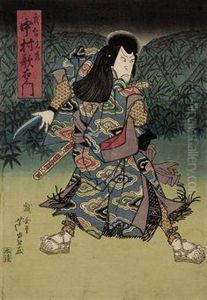Ashiyuki Paintings
Ashiyuki was a Japanese ukiyo-e artist who specialized in kabuki-e, prints depicting actors and scenes from the kabuki theater. His work was part of the osaka-school, which was centered in the city of Osaka, and he was active mainly during the late Edo period. While not as widely known as some of his contemporaries from Edo (present-day Tokyo), such as Utamaro and Hokusai, Ashiyuki's work is recognized for its distinctive style and contribution to the genre of actor prints in the Kansai region.
Ashiyuki began his artistic career under the name Asayuki, producing prints primarily of beautiful women, a common ukiyo-e theme known as bijin-ga. However, he soon shifted his focus to kabuki-e. He captured the dynamic poses and expressions of kabuki actors, often portraying them in the midst of a dramatic scene or highlighting their roles in popular plays of the time. His prints are characterized by a strong use of line and attention to the intricate patterns and textures of the costumes.
Throughout his career, Ashiyuki worked closely with kabuki theaters, actors, and publishers in Osaka. He contributed to the popularization of single-sheet yakusha-e (actor prints) and was part of a vibrant art scene that included other notable artists such as Hokushu and Hirosada. Ashiyuki's prints are valued for their historical significance, providing insights into the cultural milieu of Osaka during the period and the world of kabuki theater.
The Osaka prints are distinguishable from those produced in Edo by their distinct palette and the use of a technique known as 'beni-e,' which involved the application of a red pigment. Ashiyuki's work often featured this technique, which added a particular vibrancy to his compositions. Despite the ephemeral nature of woodblock prints and the challenges of preservation, many of Ashiyuki's works have survived, allowing contemporary audiences to appreciate his contribution to the ukiyo-e tradition.
Ashiyuki's artistic output declined towards the late 1820s, and he passed away in 1833. Although he was not as prolific as some ukiyo-e artists, his work remains an important part of the Osaka school and is studied by those interested in the regional variations within the broader ukiyo-e movement. Today, Ashiyuki's prints are held in various museum collections and continue to be appreciated by collectors and enthusiasts of Japanese woodblock prints.
